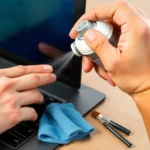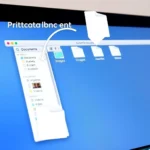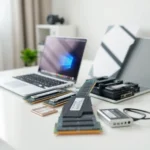Spring Cleaning Your Computer
A Comprehensive Guide
A spring clean isn't just for your house; your computer needs it too! Over time, laptops and desktops accumulate digital and physical clutter, impacting performance and user experience. Let's dive into a comprehensive guide to spring clean your computer.
Physical Cleaning. Clearing the Dust Bunnies
Just like a physical space, your computer benefits from a good spring clean.
1. Power Down and Unplug: Always start by completely powering off and unplugging your device. Safety first!
2. Clean the Exterior: Wipe down the exterior with a soft cloth, using distilled water for stubborn stains.

3. Blast Away Dust: Use compressed air to remove dust from vents, fans, and ports to prevent overheating and improve airflow. Avoid spraying liquids directly onto internal components.
4. Screen Cleaning 101:
• Essential Tools: A microfiber cloth is a must. For tough smudges, use distilled water or a mild detergent on the cloth.
• Optional Power-Ups: Consider diluted isopropyl alcohol (use cautiously on oleophobic coatings) or specialized screen wipes.
• DIY Screen Cleaner: Can't find a screen cleaner? Create your own! Here are two recipes:
• Isopropyl Alcohol Mix: 1 part isopropyl alcohol (70%) + 1 part distilled water.
• Vinegar Solution: 1 part white vinegar + 1 part distilled water.
• Important: Spray the solution onto a cloth, not directly onto the screen.
• Safety First: Avoid harsh chemicals, never spray liquids directly, and always use gentle circular motions. Test any new solution on a small area first.
5. Keyboard and Mouse Care: Use compressed air to remove debris. Wipe with a cloth and isopropyl alcohol.
6. Tidy Up Cables: Use cable ties or organizers to manage cords and reduce workspace clutter.
Digital Decluttering. Reclaiming Your Computer's Soul

Now, it's time to tackle the digital side of your spring clean.
1. Decluttering Files and Folders: Start by organizing files and decluttering. Here's how.
• Establish a Clear Folder Structure: Use broad categories like "Work," "Personal," and "Projects," and create subfolders for specific topics.
• Name Files Intuitively: Use descriptive names with dates and keywords (e.g., "2024_March_Report.pdf").
• Use Tags and Metadata: Utilize tags to categorize files and metadata for additional context.
• Automate with the right tools: Automate with tools (Hazel for Mac or DropIt for Windows) based on file type or name.
• Remove Unnecessary Files: Delete old drafts, duplicates, or files you no longer need. Back up to the cloud.
• Maintenance: Schedule reviews, regularly clean out unnecessary files and empty the Recycle Bin to maintain disk space.
2. App Purge: Uninstalling the Unused
• Identifying Unused Apps: Finding which apps you can uninstall.
• Android: In Settings, look for the "Unused Apps" option, or review via the Google Play Store by sorting apps by "least used."
• iOS: Manually review or use the "Offload Unused Apps" feature in iPhone Storage.
• Windows: Use the Control Panel or Settings app to sort apps by install date or size.
• macOS: Review the Applications folder or use the Storage tab in "About This Mac."
• Uninstalling: Follow platform-specific instructions to fully uninstall the programs.
3. Taming the Inbox:
• Unsubscribe from newsletters with tools like Unroll.me or Cleanfox.
• Close inactive email accounts and consolidate them into a single app.
4. Disk Space Management: Freeing up storage is another step to declutter the digital side of the PC.
• Run Windows' Disk Cleanup tool to remove temporary files and system files.
• Activate Storage Sense to automatically manage disk space.
• Regularly empty the Recycle Bin.
5. Limit Startup Programs: Stop unnecessary programs from automatically launching at startup.
Automating File Organization
To streamline sorting, you can use specialized tools.
• File Juggler: Monitors folders and automatically organizes files, and it is best for advanced users.
• DropIT: Drag and drop to trigger preset actions, and it is the best for minimalist workflows.

• Digital Janitor: Organizes files manually or on a schedule, it is best for simple periodic cleanup.
• WatchDirectory: Integrates with Windows utilities, it is best for power users.
• Easy File Organizer: The visual interface makes it easy to create the rules, so it is best for beginners.
Steps to implement automation
• Choose the best tool.
• Define the rules.
• Test in a Sandbox Folder.
• Schedule or Trigger Actions.
Final Touches & Ongoing Maintenance
1. Update Software: Ensure all apps are updated for security and performance.
2. Secure Passwords: Use a password manager like 1Password.
3. Back Up Regularly: Use OneDrive or external drives for backup.
4. Take Digital Breaks: Disconnect to maintain mental clarity.
5. Schedule Regular Maintenance: Set reminders for regular digital cleaning.
By following these steps, you can significantly improve your computer's performance and extend its lifespan. Start with the physical cleaning, then tackle the digital declutter, and finally set up an automated system. Happy cleaning!
Enhancing Security. Fortifying Your Digital Fortress

While cleaning up files and organizing your system is crucial, ensuring your computer's security is equally important. A well-maintained system is less susceptible to malware and unauthorized access.
Step 1: Review and Update Passwords
In the spirit of spring renewal, consider updating your passwords. Utilize a reputable password manager to generate and store complex passwords.
This practice enhances security and reduces the risk of unauthorized access.
Step 2: Enable Two-Factor Authentication (2FA)
Wherever possible, enable 2FA on your accounts. This adds an extra layer of security by requiring a second form of verification, making it more challenging for intruders to gain access.
Step 3: Conduct a Security Audit
Review the security settings of your operating system and applications. Ensure that firewalls are active, antivirus software is updated, and privacy settings are configured to your preference.
Optimizing Performance Giving Your Computer a New Lease on Life
Beyond cleaning and organizing, optimizing your system's performance can lead to a more efficient and pleasant computing experience.
Step 1: Upgrade Hardware Components
If your computer is still sluggish after a thorough cleaning, consider hardware upgrades. Adding more RAM or switching to a Solid-State

Drive (SSD) can significantly boost performance.
Step 2: Manage Background Processes
Use Task Manager (Windows) or Activity Monitor (Mac) to identify and disable unnecessary background processes that consume system resources.
Step 3: Defragment Your Hard Drive
For traditional Hard Disk Drives (HDDs), running a defragmentation tool can organize fragmented data, leading to faster read and write times. Note: This is not necessary for SSDs.
Personalizing Your Workspace. Making It Uniquely Yours

A personalized workspace can enhance productivity and make your computing experience more enjoyable.
Step 1: Customize Desktop Backgrounds and Themes
Choose wallpapers and themes that resonate with you. A fresh look can invigorate your daily routine.
Step 2: Organize Shortcuts and Widgets
Arrange your desktop shortcuts and widgets in a manner that suits your workflow. Removing clutter and keeping essential tools accessible can streamline tasks.
Step 3: Curate Playlists for Work
Create music playlists that help you focus and boost productivity. Background music can set the tone for a productive session.
Educating Yourself. Staying Informed and Empowered
Knowledge is power. Staying informed about best practices and emerging technologies can help you maintain a clean and efficient system.
Step 1: Follow Tech Blogs and Podcasts
Subscribe to reputable tech blogs and podcasts to stay updated on the latest trends, tools, and security threats.

Step 2: Participate in Online Communities
Engage with online forums and communities related to your operating system or interests. These platforms can provide support, tips, and solutions to common issues.
Step 3: Take Online Courses
Consider enrolling in online courses that enhance your digital literacy. Understanding the intricacies of your system empowers you to troubleshoot and maintain it effectively.